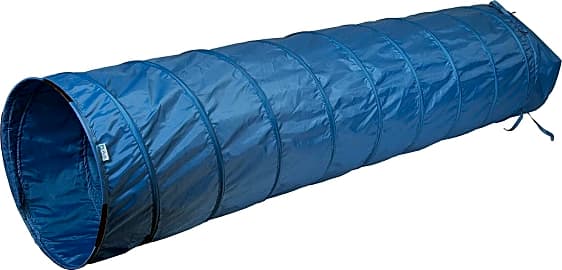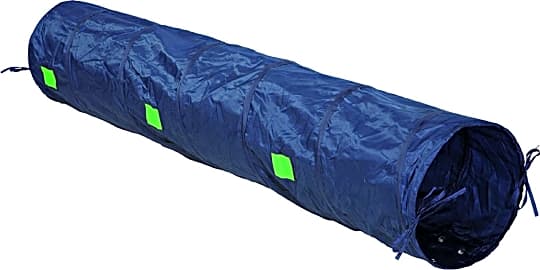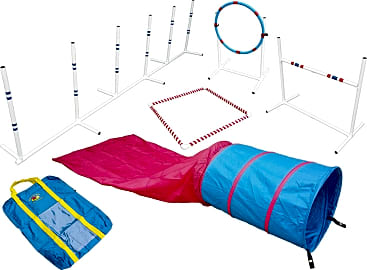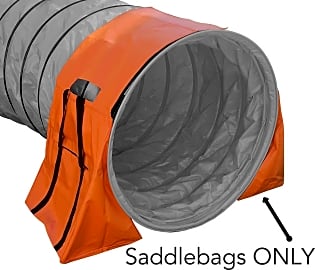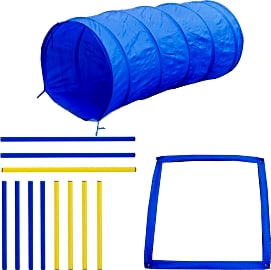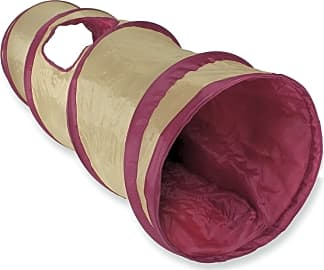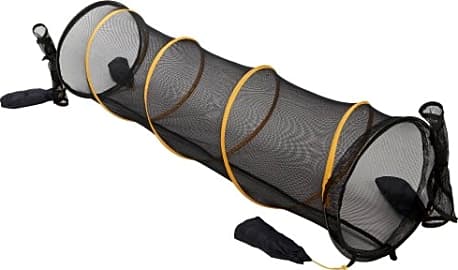The 10 Best Dog Agility Tunnels

This wiki has been updated 37 times since it was first published in June of 2016. To ensure your dog is healthy and well-adjusted, regular physical activity and mental stimulation are both important. Using one of these agility tunnels, you'll be able to fulfill these requirements, regardless of whether you're training a competitive show pup or simply giving Fido an outlet to burn off all that excess energy in a way that's fun and engaging for you both. When users buy our independently chosen editorial choices, we may earn commissions to help fund the Wiki.
Editor's Notes
February 20, 2020:
Those who have an active pup at home would do well to consider the HDP 18-Foot. It arrives with stakes and has metal grommets to ensure that it lasts for a while. We still like the Pacific Play Tents Institutional, as well, although it's pricier than many options. On the other hand, it has a robust polyester fabric that can take more abuse than some. Plus, there's a see-through version available, which can be encouraging for dogs who are feeling skittish about getting started. That's why we have kept the Outback Jack Fun Run, in fact. It's made for cats, but small dogs who need reassurance can enjoy the mesh construction. And speaking of small dogs, there's also the SmartyKat Crackle Chute. Only diminutive breeds, such as Chihuahuas, will fit in it, but it can be a lot of fun for these little animals who might be intimidated by long, large tunnels. Finally, we added one tunnel holder, the Rise8 Bag Holder. It does not arrive with a tunnel, but if you have a rambunctious animal on your hands, it will keep everything in place and stop the frustration caused by too much movement in the tunnel opening.
A last word about safety — while dog agility tunnels are relatively safe, be sure to supervise Fido, and always inspect the equipment before each session for potentially harmful rips or loose pieces. Keep in mind, too, that overtraining on hot summer days can be dangerous. Always ensure that your dog has enough water, and consider letting it rest in the shade (or on a cooling pad for dogs) to avoid overheating.
Special Honors
Ray Allen Manufacturing Training Tunnel The Ray Allen Manufacturing Training Tunnel is lightweight but sturdy, featuring UV-stabilized vinyl that is mildew resistant and made for the long haul (or, perhaps, crawl). There are two lengths available, 15 or 20 feet, as well as a choice of either blue or yellow. rayallen.com
NatureDog Terrier Tunnel The price of the NatureDog Terrier Tunnel will make it unattractive to some, but for those who want something a little different from standard options, this realistic model is one to consider. Each one is painted by hand, so they're all eye-catching and unique, but they're quite short — consider them for general play rather than truly athletic training. dog-on-it-parks.com
A Brief History Of Dog Agility Training
It's this last skill that's put to the test in competitive agility training.
Your dog would do anything to please you. He'll learn tricks, wear humiliating (but adorable) outfits, and even jump through hoops — literally. It's this last skill that's put to the test in competitive agility training.
In 1977, an English dog show promoter named John Varley realized he had a problem on his hands. There was a boring gap in his program, with spectators left to stare at an empty arena in between the obedience championships and the show judging.
Fortunately, Varley had a strong background in equestrian events, and he surmised that a competition similar to horse jumping would thrill the crowd. He grabbed a few friends (and their dogs) and put together a dog-jumping course. This first agility competition was an instant smash, as the rules were simple to follow and the audience was enthralled by the canine feats of athletic prowess.
It was so successful, in fact, that the United Kingdom Kennel Club had to deal with the existence of *illegal jumping competitions. As a result, official rules were drafted a few years later, and the obstacles were codified. In addition to simple jumping obstacles, there were now ramps, see-saws, tunnels, and more.
In 1983, the sport jumped the pond, as Texan Sandra Davis learned about it from a British competitor. She was quickly able to whip up support for American events, with the first one taking place in Houston a few years later. Hundreds of people turned out to watch, but the most important observer was the Pedigree dog food company, who began to sponsor events across the country.
The National Committee for Dog Agility was established in 1987, and the American Kennel Club allowed it to host events at recognized dog shows, further bolstering the competition's reputation. The NCDA and AKC began to organize the sport, regulating events and recognizing champions. Their events receive over a million entries each year, and the AKC's grand prize, the MACH, is one of the most coveted titles in the sport.
Today, new events and organizations are popping up all the time, and the basic drills are enjoyed in backyards and training classes the world over. Dog agility training is both fun and healthy for your dog, and it's a heck of a lot of fun to watch, as well.
And hey, any event that lets me prove that my dog is objectively better than other people's is a wonderful pastime indeed.
Training Your Dog To Use A Tunnel
One of the best things about dog agility training is that it's truly egalitarian. All mixes and sizes are welcome, regardless of whether they have a royal bloodline or they're a purebred mutt. If you want to get your dog involved, one of the best ways to start is with tunnel training.
One person should start him off in a sit-stay, then give the verbal command to send him into the tunnel, while the other waits on the far end with treats and belly rubs.
Before you begin, it's important that your pooch is in good health and responds well to basic commands. If you're going to do this in public, he should also have an even temperament and be incredibly responsive to verbal cues, as he'll need to be off-leash — and nothing will ruin your experience faster than losing your dog.
Start off by letting your dog get acclimated to the tunnel. Begin by luring him in or tossing a treat inside, then rewarding him with praise (and more cookies) when he ventures in after it.
A short, open tunnel is best for this early introduction, as you don't want your dog to panic and think he's trapped. This prevents any feelings of claustrophobia, and can help set your dog at ease while he learns the rules.
As he gets more comfortable, you can start training him to go through on command. This is best done with two people. One person should start him off in a sit-stay, then give the verbal command to send him into the tunnel, while the other waits on the far end with treats and belly rubs.
You can keep this up as you gradually lengthen the tunnel, and before long your dog will go crazy for his agility training.
How To Pick The Right Tunnel For Your Dog
Regardless of whether you want to get involved with canine agility training competitively or just to exercise your dog, having your own gear will make life easier for everyone involved.
Obviously you don't want to try to squeeze your Great Dane through a tiny little pipe, but smaller dogs may also be intimidated by cavernous passages.
When looking for a tunnel, the first consideration is the size of your dog. Obviously you don't want to try to squeeze your Great Dane through a tiny little pipe, but smaller dogs may also be intimidated by cavernous passages. Ideally, you want something with just a little bit of clearance, so that your dog can get through at full speed without hunching over.
You'll also want something that's lightweight and easily portable, especially if you'll be taking it to dog parks. Many options fold up easily and come with carrying cases, so putting them away when you're done is a breeze.
The tunnel's durability is important to think about, as well, especially if your dog is a destructive little terror. You shouldn't let him chew on it regardless, but you'll want it to be able to withstand a few bites here and there without falling apart. Make sure it's not going to easily get ripped up by his claws as he sprints through, either.
The right tunnel should provide hours of entertainment for both you and your pet. These pieces of equipment are excellent, low-cost ways to keep your dog mentally and physically stimulated, as well as provide you with the chance to spend quality time with your pooch.


